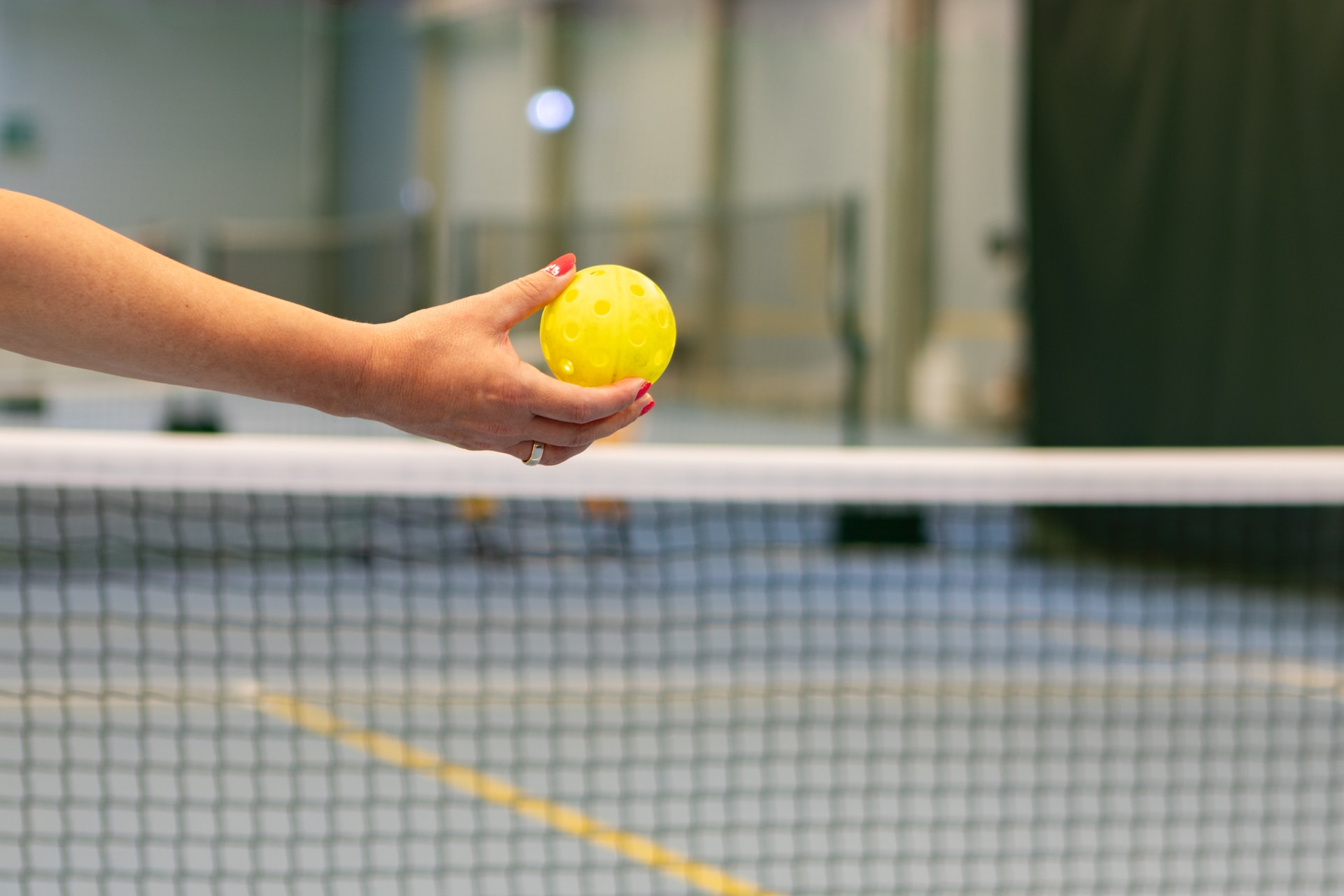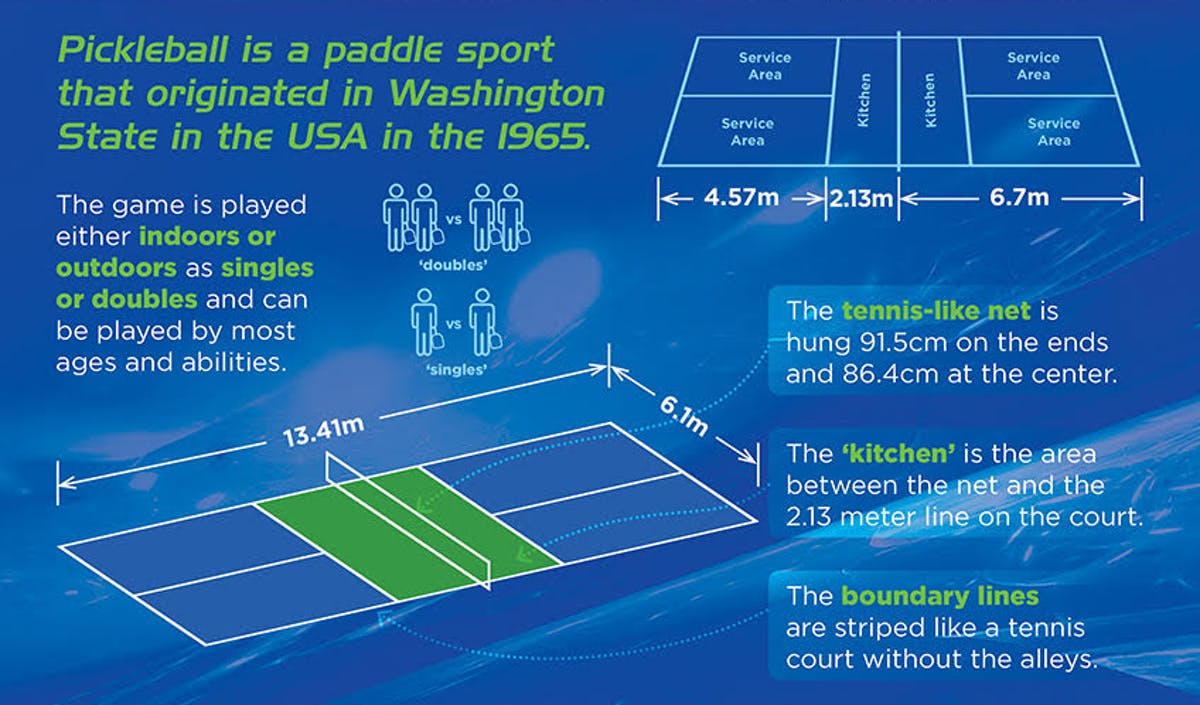
How To Play Pickleball

Pickleball is a paddle sport you can learn in minutes and play for a lifetime. It is a sport that is fun for all ages and skill levels but gets fast-paced and exhilarating at competitive levels.
- Played indoors or outdoors on an area that is very similar to a badminton-sized court - Played as either doubles or singles
- We use a solid paddle to hit a plastic ball over a low net. Games typically are played first to 11 points and take around 10-15 minutes each.
Each game starts with the serving team hitting the ball over the net. The receiving team must let it bounce (once) before returning the ball over the net. The serving team must also let the ball bounce (once) before returning it… after this, both teams generally rush forward to volley the ball back and forth, often hitting the ball rapidly between them without it touching the ground.
If the serving team faults or misses the ball, they lose the serve. But if the receiving team faults or misses the ball, the serving team scores a point. The first team to reach 11 points (as long as they’re 2 points ahead) wins the game.
Read the full USAPA rules here.
How is pickleball different from other net sports?
- It is easier to pick up than many net sports.
- It is lower impact than tennis, so it’s easier on the body.
- It focuses on quick reflexes and aiming, rather than spiking the ball, powerful serves, or running speed.
These differences open pickleball up to a greater range of players.
Whether you’ve been playing tennis your whole life, or you’re walking onto a court for the first time; whether you are young, old, or in between; whether you are strategic and competitive, or just want to get involved in something fun, social, or active…
Pickleball is for you!
The Rules of Pickleball
Each point begins with an underarm serve (paddle below the waist) by the serving team from behind the baseline.
Server 1 hits the ball diagonally into the corresponding service area of the receiving team.
The ball must clear the net and not land in the Non-Volley Zone.
(If the ball touches the net and lands in the proper service area, it is replayed.)
The serve must bounce before being hit by the receiver.
The receiver hits it back (to anywhere on the other side, including the NVZ), and this return must also bounce before being hit.
After the ball has bounced once on each side, the players are in a rally.
They can either volley the ball (hit the ball in the air without letting it bounce) or let the ball bounce once before striking it.
The rally will continue until one of the teams commits a fault, or lets the ball bounce on their side twice.
The area 7 feet on either side of the net is called the Non-Volley Zone (NVZ).
It’s common for players to stand up close to the NVZ line after the first two bounces.
It’s legal to stand in the NVZ when not hitting the ball, or when hitting the ball on the bounce, but not when volleying the ball. If a player steps into the NVZ or even touches the line during or after volleying, it’s a fault.
The player in the right service area (Server 1) serves first.
If the serving team wins the point, the Server 1 alternates position (right to left, or left to right) and serves again.
This continues until the serving team faults. The serve then goes to Server 2, who serves, alternating position each time the serving team wins a point.
This continues until the serving team faults, at which point the serve is turned over to the other team (this is called ‘side out’)
(Exception: At the start of a new game, only one player in the first serving team has the opportunity to serve and score points. When the serving team faults once, it is side out.)
If the serving team wins a rally, they win a point. The server continues serving until they fault.
If the receiving team wins a rally, they do not win a point. Either the serve changes from Server 1 to Server 2, or it’s side out.
The score is announced before every serve.
To learn how to call the score, click here.
Before each serve, the server calls out the score by saying the serving team’s score, then the opposing team’s score, then whether it is Server 1 or Server 2.
For example, a score might be 4-5-1 where the serving team has 4 points, the opposing team has 5, and Server 1 is serving.
The first team to reach 11 points (as long as they’re 2 points ahead) wins the game.
A player faults during a serve when they:
- violate any of the service rules
- touch or step over the baseline
- hit the ball anywhere other than the correct receiving court (into the NVZ, into the NVZ line, out of bounds, or into the net)
A player faults during a rally when they:
- violate any of the above rules
- let the ball bounce twice on their side of the net
- volley before the initial bounce on each side
- volley from the NVZ, or touch the NVZ in the followthrough
- hit the ball into the net or net post
- hit the ball out of bounds (a line is not considered out of bounds)
- touch the net or net post, even with their clothes or paddle
- let the ball touch any part of their body or clothing.